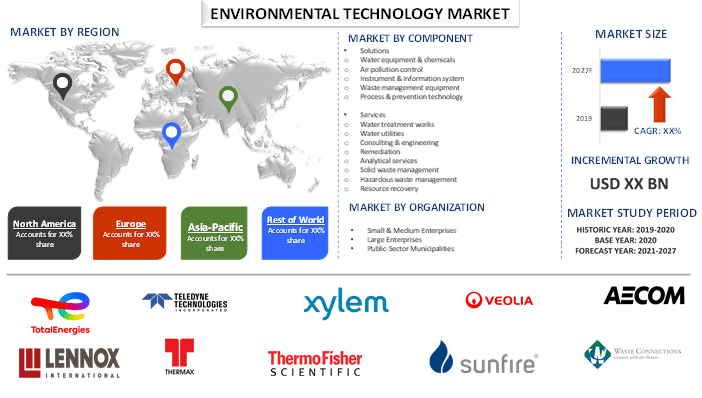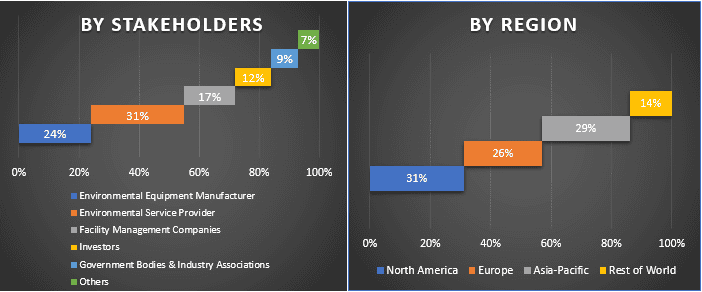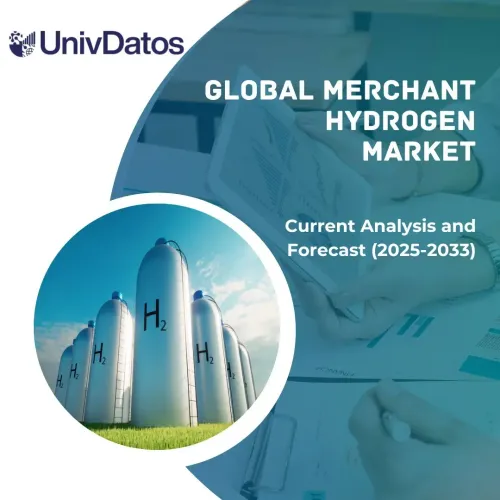- Home
- About Us
- Industry
- Services
- Reading
- Contact Us
Environmental Technology Market: Current Analysis and Forecast (2021-2027)
Emphasis on Component [(Solutions (Water Equipment & Chemicals, Air Pollution Control, Instrument & Information System, Waste Management Equipment, Process & Prevention Technology), Services (Water Treatment Works, Water Utilities, Consulting & Engineering, Remediation, Analytical Services, Solid Waste Management, Hazardous Waste Management, Resource Recovery)]; Environmental Medium (Water, Air, Soil); Organization (Small & Medium Enterprises, Large Enterprise, Public-Sector Municipalities) and Region/Country

The global environmental technology market was stood around $1.3 trillion in 2020 and is expected to demonstrate the growth of above 4% during the forecast period (2021-2027). The market is growing on account of increasing stringent governments regulations to reduce the environment non-compliance activities. Further, increasing demand of resources couple with resource scarcity is also propelling the environmental technology market. Since, environmental resources plays a key role in industrial production therefore using them increase the demand of technology to efficiently utilize and reuse resources. For instance, in US, water treatment and reuse industry witnessing large investment and development to produce natural gas using hydraulic fracturing technique owing to high cost of water in hydraulic fracturing operation. For instance, as per the data published by International Trade Administration, the productive value of a cubic meter of water in the hydraulic fracturing process is estimated to be about US$1.54. Comparatively, a cubic meter of water used in agriculture has a productive value of approximately US$0.13, demonstrating that investments in water efficiency enhance profits for natural gas producers.
The environmental technology market affected negatively in the light of COVID-19. Strict measures taken by the governments all around the globe, has affected the settings like commercial and industrial sector. Owing to which demand for environmental technology products and services fall. However, since countries has set their respective goals to decarbonize the environment, therefore the environmental technology industry is likely to recover in a short timeframe.
Insights Presented in the Report
“Amongst component, service category held the larger revenue share in 2020.”
Based on component, market is categorized into solutions and services. Among these, services category held the larger market share in 2020 and is expected to retain its position during the forecast period. Since, with increasing demand of environment resources, demand for proper maintenance, utilization, waste management, resource recovery, and analytical services is increasing to maximize environmental resource efficiency. Further, to comply with government strict regulations, companies are taking engineering & consulting services to transform their business.
“Amongst environmental medium, water sector held prominent position in 2020.”
Based on environmental medium, the market is categorized into water, air, and soil. Among these, water category held the considerable market share owing to increasing concern related to water recycling thus large investment in the water treatment and reuse sector. Further, air category is also like to grow at a faster rate owing to increasing initiatives to reduce the carbon emission
“In 2020, North America captured significant portion of pie owing to increasing investment and strict regulation”
For better understanding of the market, the report provides detail analysis for major region and country including North America (US, Canada); Europe (Germany, UK, France, Spain, rest of Europe); Asia-Pacific (China, Japan, India, Australia, Rest of Asia-Pacific) and Rest of World. During the forecast period, North America region held the significant market share owing to large government and private sector investment in environment technologies. Further, stringent environment regulation set by EPA propel the market growth. Some of the major companies operating in the global environmental technology market includes TotalEnergies SE, Teledyne Technologies Incorporated, AECOM, Lennox International, Xylem Inc., Thermax Ltd., Veolia, Thermo Scientific Inc., Waste Connection Inc., and Sunfire GmbH.
Reasons to buy this report:
- The study includes market sizing and forecasting analysis validated by authenticated key industry experts
- The report presents a quick review of overall industry performance at one glance
- The report covers in-depth analysis of prominent industry peers with a primary focus on key business financials, product portfolio, expansion strategies, and recent developments
- Detailed examination of drivers, restraints, key trends, and opportunities prevailing in the industry
- The study comprehensively covers the market across different segments
- Deep dive country level analysis of the industry
Customization Options:
The global environmental technology Market can further be customized as per the requirement or any other market segment. Besides this, UMI understands that you may have your own business needs, hence feel free to connect with us to get a report that completely suits your requirements.
Table of Content
Analyzing the historical market, estimation of the current market, and forecasting the future market of the Environmental Technology three major steps undertaken to create and analyze its adoption across the globe. Exhaustive secondary research was conducted to collect the historical market numbers and estimate the current market size. Secondly, to validate these insights, numerous findings and assumptions were taken into consideration. Moreover, exhaustive primary interviews were also conducted, with industry experts across the value chain of the environmental technology industry. Post assumption and validation of market numbers through primary interviews, we employed a bottom-up approach to forecast the complete market size. Thereafter, market breakdown and data triangulation methods were adopted to estimate and analyze the market size of segments and sub-segments the industry pertains to. Detailed methodology is explained below:
Analysis of Historical Market Size
Step 1: In-Depth Study of Secondary Sources:
Detail secondary study was conducted to obtain the historical market size of the environmental technology through company internal sources such as annual report & financial statements, performance presentations, press releases, etc., and external sources including journals, news & articles, government publications, competitor publications, sector reports, third-party database, and other credible publications.
Step 2: Market Segmentation:
After obtaining the historical market size of the environmental technology market, we conducted a detailed secondary analysis to gather current market insights and share for different segments & sub-segments for major regions. Major segments included in the report are by component, environmental medium, and organization. Further regional and country-level analyses were conducted to evaluate the overall adoption of the environmental technology globally.
Step 3: Factor Analysis:
After acquiring the historical market size of different segments and sub-segments, we conducted a detailed factor analysis to estimate the current market size of Environmental Technology. Further, we conducted factor analysis using dependent and independent variables such as increasing government initiatives to protect the environment and rising concern related to resource scarcity. A thorough analysis was conducted for demand and supply-side scenario considering increasing investment, top partnerships, merger and acquisition, business expansion, and product launches in the Environmental Technology industry.
Current Market Size Estimate & Forecast
Current Market Sizing: Based on actionable insights from the above 3 steps, we arrived at the current market size, key players in the global environmental technology market, and market shares of each segment. All the required percentage shares split, and market breakdowns were determined using the above-mentioned secondary approach and were verified through primary interviews.
Estimation & Forecasting: For market estimation and forecast, weights were assigned to different factors including drivers & trends, restraints, and opportunities available for the stakeholders. After analyzing these factors, relevant forecasting techniques i.e., bottom-up approach was applied to arrive at the market forecast to 2027 for different segments and subsegments across the major regions globally. The research methodology adopted to estimate the market size encompasses:
- The industry’s market size, in terms of value (US$) and the adoption rate of environmental technology across the major markets
- All percentage shares, splits, and breakdowns of market segments and sub-segments
- Key players in the environmental technology market in terms of products offered. Also, the growth strategies adopted by these players to compete in the fast-growing market.
Market Size and Share Validation
Primary Research: In-depth interviews were conducted with the Key Opinion Leaders (KOLs) including Top Level Executives (CXO/VPs, Sales Head, Marketing Head, Operational Head, and Regional Head, Country Head, etc.) across major regions. Primary research findings were then summarized, and statistical analysis was performed to prove the stated hypothesis. Inputs from primary research were consolidated with secondary findings, hence turning information into actionable insights.
Split of Primary Participants in Different Regions

Market Engineering
Data triangulation technique was employed to complete the overall market estimation and to arrive at precise statistical numbers of each segment and sub-segment of the global environmental technology market. Data was split into several segments & sub-segments post studying various parameters and trends in the areas of component, environmental medium, and organization.
The main objective of the Environmental Technology market study
The current & future market trends of global environmental technology were pinpointed in the study. Investors can gain strategic insights to base their discretion for investments from the qualitative and quantitative analysis performed in the study. Current and future market trends would determine the overall attractiveness of the market at a country level, providing a platform for the industrial participant to exploit the untapped market to benefit as a first-mover advantage. Other quantitative goals of the studies include:
- Analyze the current and forecast market size of environmental technology in terms of value (US$). Also, analyze the current and forecast market size of different segments and sub-segments
- Segments in the study include areas of components, environmental medium, and organization
- Defined analysis of the regulatory framework for the environmental technology industry
- Analyze the value chain involved with the presence of various intermediaries, along with analyzing customer and competitor behaviors of the industry
- Analyze the current and forecast market size of the environmental technology for the major countries
- Major regions/countries analyzed in the report includes North America (US, Canada), Europe (Germany, UK, France, Spain, Rest of Europe), Asia-Pacific (China, Japan, India, Australia, Rest of Asia-Pacific), and Rest of World
- Company profiles of the environmental technology market players and the growth strategies adopted by them to sustain in the growing market
- Deep dive country level analysis of the industry
Related Reports
Customers who bought this item also bought










